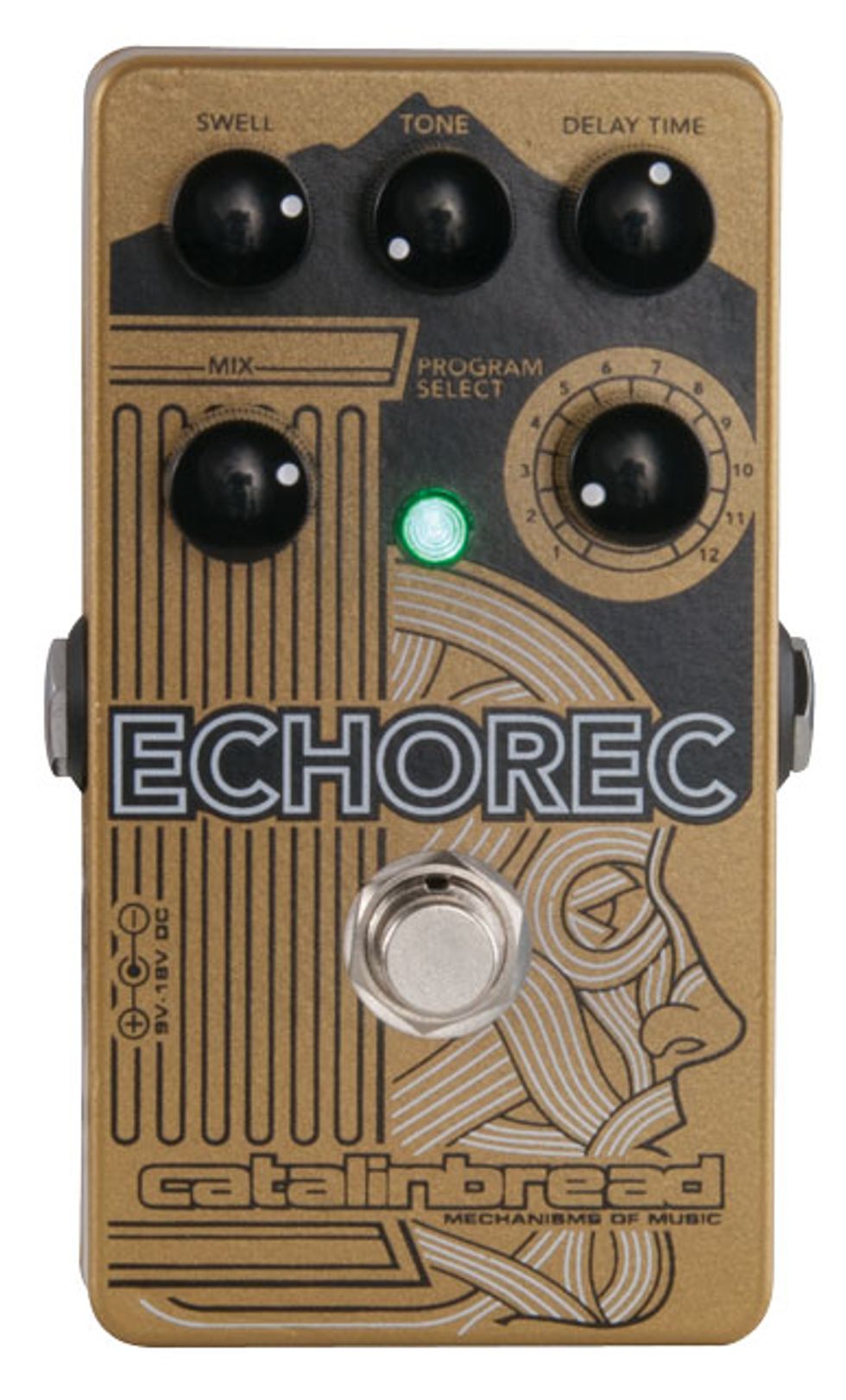Though it’s not exactly a secret among the effects cognoscenti, the Binson Echorec may be one of the most widely heard effects nobody ever heard of. That so many have enjoyed the strange, lush atmospherics of the Echorec—if not it’s name—is thanks largely to Syd Barrett and David Gilmour. The latter’s embrace and front-and-center use of the Binson has, over time, made the Echorec a Holy Grail for Pink Floyd-fixated tone hunters. In Barrett’s hands, however, the Binson’s unusual multi-head design and capacity for convoluted, syncopated, and interstellar repeats helped shape the foundations of U.K. psychedelia. All told, that’s a pretty significant musical impact for an echo generator long since eclipsed in fame by a half-dozen others.
Though the Binson Echorec has been the subject of high-powered DSP and software-based approximations, Catalinbread’s Echorec is one of the first compact stompboxes to so specifically attempt to replicate the sounds and functionality of the original. That’s because the original was a freak of audio engineering so brimming with switches and knobs that it looks more like an old organ or primitive analog drum machine. In short, it ain’t easy to make an Echorec. Yet the relative mechanical and operational complexity is part of what made the Binson so musical and expressive. Though Catalinbread’s take on it performs different from an original, it too prompts inventive approaches, opens up rhythmic possibilities, and sounds excellent.
Pillars of Sound That Catalinbread was able to boil down so much of the Binson’s wild functionality to five knobs is impressive. The originals had four fixed playback heads, a magnetic drum, and switches to activate combinations of playback heads. Many controls on Catalinbread’s gold, Pink Floyd: Live at Pompeii-inspired version will be familiar to vintage Echorec users, though they differ a bit in practice. Swell is essentially the feedback control, though increased levels also emphasize modulation and warble in the repeats, which can be adjusted via an internal trim pot. The powerful tone knob has a considerable, very organic-feeling effect on repeats, modulation, and how the two interact.
Unlike original Binsons, which had four basic delay times based on the position of the fixed heads, the Catalinbread can go from 40 ms to a full second. It also maintains a uniform division between repeats in a multi-head setting—a 100 ms setting is 25ms between heads, a 1,000 ms setting is 250 ms between heads, and so on—which really expands on the original’s potential. The mix control works conventionally, moving from totally dry to completely wet. But it’s the program select knob that’s the key to the Catalinbread’s magic. Just as on the original Binson, it’s a 12-position dial selects nearly every possible “head” configuration. It cracks open a universe of very intuitive, easy-to-tailor rhythmic delays and unique, positively expansive ambient textures. An internal switch also let’s you select trails or buffered switching modes.
Sonic Vesuvius The Echorec’s basic voice is lovely—organic and colorful without being overly so, with a fascinating combination of digital precision and analog fuzziness. Repeats taper away with a natural but slightly metallic-sounding decay that honors the magneto-mechanical repeat origins of the Binson. I preferred setting the internal modulation pot fairly deep and then fine-tuning with the tone control. Bassier tones are key to finding the pedal’s subtler side. Treblier settings, however, emphasize overtones and complex oscillation harmonics—quite like listening to the wobbling waves of decay you hear from a big church bell at close proximity. These settings are a wonderland for spacious leads or solo instrumentals, reward a dynamic picking approach and suspended-chord- or open-tuning-based compositions with ringing open strings. And if you like a lot of reverb, you’ll love how the densest repeat modes almost eliminate the need for one—especially position 12, where all four “heads” create a regenerating wash that’s rich with overtones and ghost oscillations.
One of the biggest upsides of the Catalinbread is its rhythmic delay potential. A setting that takes one “head” out of the mix and adds another creates a basic syncopation that you can accent and enhance with the delay time. The beat- and tempo-shaping power of the delay time control in these syncopated settings is probably the biggest improvement upon the original (that and eliminating the need for mechanical maintenance), and the ease with which they work together is one of the most significant differences between the Catalinbread and other delays.
Ratings
Pros:
Unique, enveloping, atmospheric, and organic delays that inspire and turn heads. Rhythmic delays are simple to dial in.
Cons:
Simpler, more conventional delay sounds can be tricky.
Tones:
Ease of Use:
Build/Design:
Value:
Street:
$230
Catalinbread
catalinbread.com
The pedal’s 12-position control is perhaps its only weak spot—it doesn’t have detents that click so you know you’re in the mode indicated by the miniscule print on the chassis. That means there’s potential for fairly excruciating lost-in-the-woods moments on a dark stage, especially given how adjacent settings can have very distinct rhythmic signatures that could significantly disrupt a performance. In a well-lit room, this isn’t a huge deal, but addressing these issues would make the Catalinbread much more practical for gigging.
The Verdict Few delays have ever so deftly and creatively mated digital’s definition and analog’s earthiness as the Echorec. Even fewer have felt like such a cool and elegant departure from convention. Catalinbread clearly put a lot of love, research, and engineering resources into this pedal, and it pays off spectacularly in vintage authenticity, musicality, and creative potential.
At 230 bucks, it’s on the expensive side—exorbitant for players with basic delay needs. But ambient adventurers, post-rock texturalists, pickers with cinematic sensibilities, and players who love vintage Pink Floyd and golden-age-of-psychedelic sonics will probably consider it a bargain, plug it in, and go wild like sugar-crazed 8-year-olds in a toy store—even if it takes a little saving for most of us to get one.









![Rig Rundown: Russian Circles’ Mike Sullivan [2025]](https://www.premierguitar.com/media-library/youtube.jpg?id=62303631&width=1245&height=700&quality=70&coordinates=0%2C0%2C0%2C0)

















